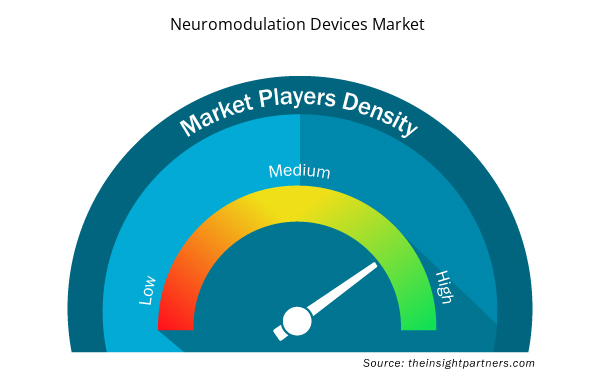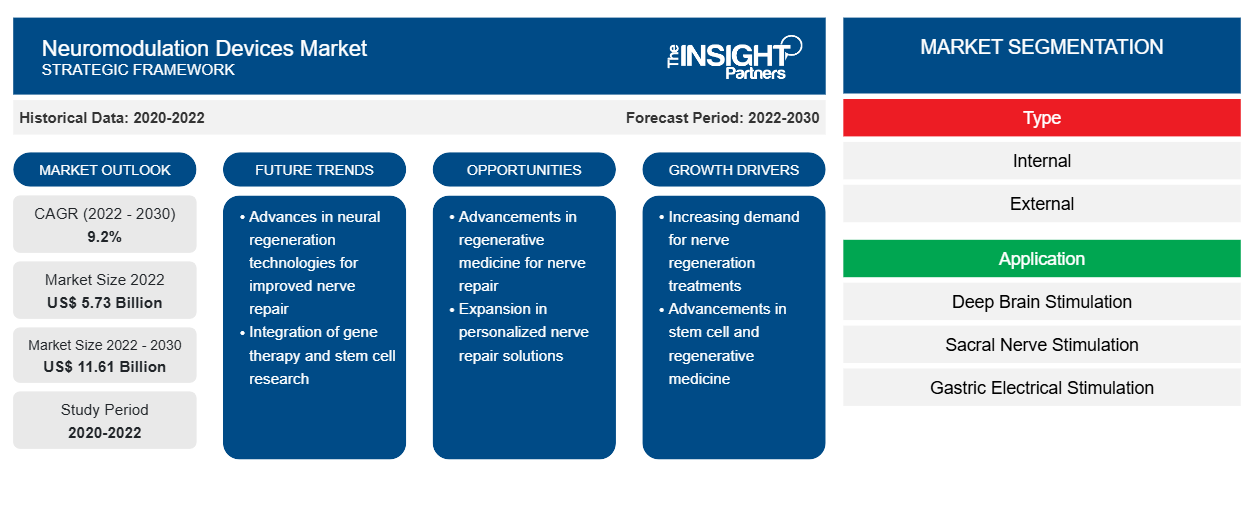[調査レポート] 神経調節デバイス市場は2022年に57億3,000万米ドルと評価され、2030年までに116億1,000万米ドルに達すると予想されています。市場は2022年から2030年にかけて9.2%のCAGRを記録すると予測されています。
市場洞察とアナリストの見解:
このレポートには、現在の神経調節デバイス市場の動向と予測期間中の予測可能な影響とともに、成長の見通しも含まれています 。
ニューロモジュレーションの使用は急速に増加しており、神経精神疾患および神経疾患の治療には、さまざまな埋め込み型および非侵襲性の技術ベースの方法が使用されています。頭蓋内皮質刺激法 (ICS)、経頭蓋磁気刺激法 (TMS)、脳深部刺激法 (DBS)、経頭蓋直流刺激法 (tDCS) などの治療法は、さまざまな神経精神疾患および神経疾患で有望な結果を示しています。ニューロモジュレーション デバイスは、神経系の活動を調整できる高度な医療機器です。この技術は、ジストニア、パーキンソン病、振戦、耳鳴り、強迫性障害、感覚障害、てんかん、膀胱制御、頭痛、慢性疼痛、脳卒中、最小意識状態、痙縮、脊髄損傷などの運動障害の治療に使用されます。脊髄損傷の症例の増加や神経疾患の有病率の増加などの要因が、ニューロモジュレーション デバイスの市場規模の拡大に貢献しています。
市場の推進要因:
高齢者は神経疾患にかかりやすい。高齢者によく見られる神経疾患は、神経障害、パーキンソン病、アルツハイマー病、ジストニアなどである。国連経済社会局によると、2022年の世界では65歳以上の人口は7億7100万人。高齢者人口は2030年までに9億9400万人、2050年までに16億人に達すると予想されている。米国やカナダなどの国では、高齢者人口の増加に伴い、運動障害や精神疾患の有病率が高くなっている。パーキンソン病財団によると、パーキンソン病の症状は平均年齢60歳でよく見られる。
カナダ心理学会によると、強迫性障害 (OCD) はカナダの人口の約 2% に影響を与えています。世界保健機関 (WHO) によると、てんかんは発作を引き起こす神経疾患で、世界中で約 5,000 万人が影響を受けています。米国神経学会によると、脳卒中は米国で 3 番目に多い死因であり、アルツハイマー病が 6 番目に多い死因です。同じ情報源の統計によると、約 100 万人の米国人がパーキンソン病に罹患しており、少なくとも毎年 6 万人の新規症例が報告されています。神経疾患の罹患率の増加と、うつ病や慢性疼痛などの生活習慣病が相まって、技術的に高度な製品の採用が増加しています。OCD) affects about 2% of the population in Canada. The World Health Organization (WHO) states that
したがって、神経疾患にかかりやすい高齢者人口の増加、疾患の有病率の上昇、神経障害の多大な負担に関する意識の高まりが、神経調節デバイス市場の成長を促進します。neuromodulation devices market growth.
神経科学は、脳卒中、頭痛障害、多発性硬化症、その他の重篤な症例などの疾患の治療に重点を置いています。近年、先進国でも熟練した神経内科医療従事者の相対的な不足が見られます。米国には5,700を超える病院がありますが、これらの病院には3,700人未満の脳神経外科医がいます。脳神経外科医療従事者の不足の主な要因は、適切な時間内に十分に訓練された脳神経外科医を育成できないことです。都市部では高度な技術を備えた神経科施設を利用できます。しかし、専門家の不足により、地方では限られた治療しか提供されていません。したがって、熟練した脳神経外科医の不足は、神経調節デバイス市場の成長を妨げています。
要件に合わせてレポートをカスタマイズする
このレポートの一部、国レベルの分析、Excelデータパックなど、あらゆるレポートを無料でカスタマイズできます。また、スタートアップや大学向けのお得なオファーや割引もご利用いただけます。
- このレポートの主要な市場動向を入手してください。この無料サンプルには、市場動向から見積もりや予測に至るまでのデータ分析が含まれます。
レポートのセグメンテーションと範囲:
「神経調節デバイス市場分析」は、タイプ、用途、生体材料、エンドユーザーなどのセグメントを考慮して実施されました。
セグメント分析:
神経調節デバイス市場は、タイプ別に外部と内部に分かれています。内部神経調節セグメントは、2022 年に神経調節デバイスの市場シェアを大きく占めました。ただし、外部神経調節セグメントは、2022 年から 2030 年にかけてより高い CAGR を記録する可能性があります。「内部神経調節」という用語は、神経系の活動を調整または変更するために、特定のニューロンターゲットに電気的、化学的、またはその他の形式の刺激を提供する医療機器の使用を表します。この技術は、神経血管疾患、運動異常、てんかん、慢性疼痛、および便失禁と尿失禁の治療に使用されます。
エンドユーザー別に見ると、ニューロモジュレーションデバイス市場は、病院、診療所、在宅医療に分類されます。2022年には、病院セグメントがニューロモジュレーションデバイス市場シェアを独占しました。多数の病院や診療所の拡大と、医療インフラ構築のための政府支出の増加により、現在、病院セグメントが市場を独占しています。さらに、人口の高齢化により慢性疼痛の有病率が高くなり、病院でのニューロモジュレーションデバイスの需要が高まると予想されています。
地域分析:
ニューロモジュレーションデバイス市場レポートの範囲は、主に北米(米国、カナダ、メキシコ)、ヨーロッパ(スペイン、英国、ドイツ、フランス、イタリア、その他のヨーロッパ)、アジア太平洋(韓国、中国、インド、日本、オーストラリア、その他のアジア太平洋)、中東およびアフリカ(南アフリカ、サウジアラビア、UAE、その他の中東およびアフリカ)、南米および中米(ブラジル、アルゼンチン、その他の南米および中米)に区分されています。
収益の面では、北米が2022年に神経調節デバイスの市場シェアを独占しました。神経疾患の蔓延、研究開発への多額の支出、FDAによる製品承認数の増加、技術の進歩により、この地域での神経調節デバイスの需要が高まっています。
神経調節デバイス市場の地域別洞察
予測期間を通じてニューロモジュレーション デバイス市場に影響を与える地域的な傾向と要因は、Insight Partners のアナリストによって徹底的に説明されています。このセクションでは、北米、ヨーロッパ、アジア太平洋、中東、アフリカ、南米、中米にわたるニューロモジュレーション デバイス市場のセグメントと地理についても説明します。

- 神経調節デバイス市場の地域別データを入手
神経調節デバイス市場レポートの範囲
| レポート属性 | 詳細 |
|---|---|
| 2022年の市場規模 | 57億3千万米ドル |
| 2030年までの市場規模 | 116億1000万米ドル |
| 世界のCAGR(2022年 - 2030年) | 9.2% |
| 履歴データ | 2020-2022 |
| 予測期間 | 2022-2030 |
| 対象セグメント | タイプ別
|
| 対象地域と国 | 北米
|
| 市場リーダーと主要企業プロフィール |
|
神経調節デバイス市場のプレーヤー密度:ビジネスダイナミクスへの影響を理解する
ニューロモジュレーション デバイス市場は、消費者の嗜好の変化、技術の進歩、製品の利点に対する認識の高まりなどの要因により、エンド ユーザーの需要が高まり、急速に成長しています。需要が高まるにつれて、企業は提供内容を拡大し、消費者のニーズを満たすために革新を起こし、新たなトレンドを活用し、市場の成長をさらに促進しています。
市場プレーヤー密度とは、特定の市場または業界内で活動している企業または会社の分布を指します。これは、特定の市場スペースに、その市場規模または総市場価値に対してどれだけの競合相手 (市場プレーヤー) が存在するかを示します。
ニューロモジュレーションデバイス市場で事業を展開している主要企業は次のとおりです。
- アボット(セント・ジュード・メディカル社)
- リヴァノヴァPLC
- ボストン・サイエンティフィック・コーポレーション
- アレバ ニューロセラピューティクス SA
- ビオベンタス
免責事項:上記の企業は、特定の順序でランク付けされていません。

- 神経調節デバイス市場のトップキープレーヤーの概要を入手
競争環境と主要企業:
ニューロモジュレーション デバイス市場レポートは、Abbott (St. Jude Medical, Inc)、LivaNova PLC、Boston Scientific Corporation、Aleva Neurotherapeutics SA、Bioventus、EnteroMedics Inc、Nevro Corporation、NeuroPace Inc、Synapse Biomedical Inc、Neurosigma Inc などの市場の主要企業に焦点を当てています。ニューロモジュレーション デバイス市場の予測は、関係者が成長戦略を計画するのに役立ちます。これらの企業は、世界中で高まる消費者の需要を満たすために、新しいテクノロジー、既存製品のアップグレード、および市場の拡大に重点を置いています。各社のプレス リリースによると、最近の重要な開発は次のとおりです。
- 2023 年 8 月、メドトロニック社は、閉ループ充電式脊髄刺激装置 (SCS) Inceptiv の CE マーク承認を取得しました。これは、各人の固有の生体信号を感知し、必要に応じて刺激を瞬間ごとに調整して、日常生活の動作と調和した治療を維持する閉ループ機能を備えた最初のメドトロニック SCS デバイスです。
- 2023 年 8 月、アボットは FlexBurst360 療法を特徴とする新しい Proclaim Plus 脊髄刺激 (SCS) システムについて、米国食品医薬品局 (FDA) の承認を取得しました。アボット独自の BurstDR 刺激の次世代である FlexBurst360 療法は、体幹および/または四肢の 6 つの領域にわたる痛みをカバーします。これにより、個人の治療ニーズに応じて調整できるプログラミングが容易になります。
- 過去2年間の分析、基準年、CAGRによる予測(7年間)
- PEST分析とSWOT分析
- 市場規模価値/数量 - 世界、地域、国
- 業界と競争環境
- Excel データセット



Report Coverage
Revenue forecast, Company Analysis, Industry landscape, Growth factors, and Trends

Segment Covered
This text is related
to segments covered.

Regional Scope
North America, Europe, Asia Pacific, Middle East & Africa, South & Central America

Country Scope
This text is related
to country scope.
よくある質問
The neuromodulation device market, based on end user, segmented into hospitals, clinics, and home healthcare. In 2022, the hospitals segment dominated the neuromodulation devices market share.
Asia Pacific is expected to be the fastest growing region in the neuromodulation device market. The rising prevalence of neurological diseases and the development of neuromodulation devices are likely to enhance the market's growth in the coming years. China is among the most populated countries in the world, and the country has a maximum number of patients suffering from neurological disorders.
The neuromodulation device market, based on application, is segmented into metallic, polymeric, and ceramic. In 2022, the metallic segment dominated the market share. However, the polymeric segment is likely to register the highest CAGR during 2022–2030.
The neuromodulation device market, based on application, is segmented into deep brain stimulation (DBS), sacral nerve stimulation (SNS), gastric electrical stimulation (GES), spinal cord stimulation (SCS), and vagus nerve stimulation (VNS). The spinal cord stimulation segment held the largest market share in 2022 and is expected to record the highest CAGR in the market during 2022–2030.
The neuromodulation device market, based on type, is bifurcated into external and internal. The internal neuromodulation segment held a larger neuromodulation devices market share in 2022. However, the external neuromodulation segment is likely to register a higher CAGR during 2022–2030.
US holds the largest market share in neuromodulation device market. the incidence of neurovascular diseases is rising significantly, and it is among the leading causes of death across the country. Rising incidence of neurological diseases such as Parkinson's disease (PD), increasing awareness about neurological disorders, and growing investments in developing transcranial stimulators are among the main factors driving the overall neuromodulation devices market growth in the US.
The neuromodulation device market majorly consists of the players such as Abbott (St. Jude Medical, Inc.), LivaNova PLC, Boston Scientific Corporation, Aleva Neurotherapeutics SA, Bioventus, EnteroMedics Inc, Nevro Corporation, NeuroPace Inc, Synapse Biomedical Inc, Neurosigma Inc among others.
The factors that are driving growth of the market are the rising cases of spinal cord injury and increasing prevalence of neurological disorders.
Neuromodulation use is growing rapidly, with a wide range of implantable and noninvasive technology-based methods for the treatment of neuropsychiatric and neurological disorders. Therapies such as intracranial cortical stimulation (ICS), transcranial magnetic stimulation (TMS), deep brain stimulation (DBS), and transcranial direct current stimulation (tDCS) have shown promising results across a range of neuropsychiatric and neurological disorders. Neuromodulation devices are advanced medical instruments that can adjust the activity of the nervous system. The technology is used to treat movement disorders such as dystonia, Parkinson’s disease, and tremor; tinnitus; obsessive compulsive disorder; sensory disabilities; epilepsy; bladder control; headache; chronic pain; stroke; minimally conscious state; spasticity; and spinal cord injury.
Trends and growth analysis reports related to Life Sciences : READ MORE..
The List of Companies - Neuromodulation Devices Market
- Abbott (St. Jude Medical, Inc.)
- LivaNova PLC
- Boston Scientific Corporation
- Aleva Neurotherapeutics SA
- Bioventus
- EnteroMedics Inc.
- Nevro Corporation
- NeuroPace Inc.
- Synapse Biomedical, Inc.
- Neurosigma, Inc
The Insight Partners performs research in 4 major stages: Data Collection & Secondary Research, Primary Research, Data Analysis and Data Triangulation & Final Review.
- Data Collection and Secondary Research:
As a market research and consulting firm operating from a decade, we have published and advised several client across the globe. First step for any study will start with an assessment of currently available data and insights from existing reports. Further, historical and current market information is collected from Investor Presentations, Annual Reports, SEC Filings, etc., and other information related to company’s performance and market positioning are gathered from Paid Databases (Factiva, Hoovers, and Reuters) and various other publications available in public domain.
Several associations trade associates, technical forums, institutes, societies and organization are accessed to gain technical as well as market related insights through their publications such as research papers, blogs and press releases related to the studies are referred to get cues about the market. Further, white papers, journals, magazines, and other news articles published in last 3 years are scrutinized and analyzed to understand the current market trends.
- Primary Research:
The primarily interview analysis comprise of data obtained from industry participants interview and answers to survey questions gathered by in-house primary team.
For primary research, interviews are conducted with industry experts/CEOs/Marketing Managers/VPs/Subject Matter Experts from both demand and supply side to get a 360-degree view of the market. The primary team conducts several interviews based on the complexity of the markets to understand the various market trends and dynamics which makes research more credible and precise.
A typical research interview fulfils the following functions:
- Provides first-hand information on the market size, market trends, growth trends, competitive landscape, and outlook
- Validates and strengthens in-house secondary research findings
- Develops the analysis team’s expertise and market understanding
Primary research involves email interactions and telephone interviews for each market, category, segment, and sub-segment across geographies. The participants who typically take part in such a process include, but are not limited to:
- Industry participants: VPs, business development managers, market intelligence managers and national sales managers
- Outside experts: Valuation experts, research analysts and key opinion leaders specializing in the electronics and semiconductor industry.
Below is the breakup of our primary respondents by company, designation, and region:

Once we receive the confirmation from primary research sources or primary respondents, we finalize the base year market estimation and forecast the data as per the macroeconomic and microeconomic factors assessed during data collection.
- Data Analysis:
Once data is validated through both secondary as well as primary respondents, we finalize the market estimations by hypothesis formulation and factor analysis at regional and country level.
- Macro-Economic Factor Analysis:
We analyse macroeconomic indicators such the gross domestic product (GDP), increase in the demand for goods and services across industries, technological advancement, regional economic growth, governmental policies, the influence of COVID-19, PEST analysis, and other aspects. This analysis aids in setting benchmarks for various nations/regions and approximating market splits. Additionally, the general trend of the aforementioned components aid in determining the market's development possibilities.
- Country Level Data:
Various factors that are especially aligned to the country are taken into account to determine the market size for a certain area and country, including the presence of vendors, such as headquarters and offices, the country's GDP, demand patterns, and industry growth. To comprehend the market dynamics for the nation, a number of growth variables, inhibitors, application areas, and current market trends are researched. The aforementioned elements aid in determining the country's overall market's growth potential.
- Company Profile:
The “Table of Contents” is formulated by listing and analyzing more than 25 - 30 companies operating in the market ecosystem across geographies. However, we profile only 10 companies as a standard practice in our syndicate reports. These 10 companies comprise leading, emerging, and regional players. Nonetheless, our analysis is not restricted to the 10 listed companies, we also analyze other companies present in the market to develop a holistic view and understand the prevailing trends. The “Company Profiles” section in the report covers key facts, business description, products & services, financial information, SWOT analysis, and key developments. The financial information presented is extracted from the annual reports and official documents of the publicly listed companies. Upon collecting the information for the sections of respective companies, we verify them via various primary sources and then compile the data in respective company profiles. The company level information helps us in deriving the base number as well as in forecasting the market size.
- Developing Base Number:
Aggregation of sales statistics (2020-2022) and macro-economic factor, and other secondary and primary research insights are utilized to arrive at base number and related market shares for 2022. The data gaps are identified in this step and relevant market data is analyzed, collected from paid primary interviews or databases. On finalizing the base year market size, forecasts are developed on the basis of macro-economic, industry and market growth factors and company level analysis.
- Data Triangulation and Final Review:
The market findings and base year market size calculations are validated from supply as well as demand side. Demand side validations are based on macro-economic factor analysis and benchmarks for respective regions and countries. In case of supply side validations, revenues of major companies are estimated (in case not available) based on industry benchmark, approximate number of employees, product portfolio, and primary interviews revenues are gathered. Further revenue from target product/service segment is assessed to avoid overshooting of market statistics. In case of heavy deviations between supply and demand side values, all thes steps are repeated to achieve synchronization.
We follow an iterative model, wherein we share our research findings with Subject Matter Experts (SME’s) and Key Opinion Leaders (KOLs) until consensus view of the market is not formulated – this model negates any drastic deviation in the opinions of experts. Only validated and universally acceptable research findings are quoted in our reports.
We have important check points that we use to validate our research findings – which we call – data triangulation, where we validate the information, we generate from secondary sources with primary interviews and then we re-validate with our internal data bases and Subject matter experts. This comprehensive model enables us to deliver high quality, reliable data in shortest possible time.


 このレポートの無料サンプルを入手する
このレポートの無料サンプルを入手する